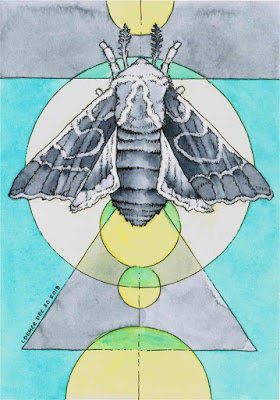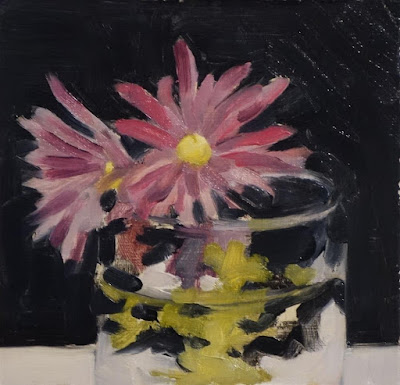 From Liz's DPW Gallery Page:
From Liz's DPW Gallery Page:Hi there! I'm a Canadian-American artist and illustrator currently living in the beautiful Okanagan Valley of British Columbia. I'm an accountant by day, but at night I like to hide in my studio (aka at my dining room table) and create weird shit. I work primarily in small-format ink and watercolor, and love to use surreal moments and characters to create scenes of whimsy and danger.
I also create tutorials for many of my works! Interested in the process? Want to see the play-by-play of how an image progresses? Just need confirmation that every painting looks terrible about halfway through? Please check out my website to see fun tutorials like the one for "Don't Feed the Bears" below. Thank you for checking out my site!
Tell us a bit about how you first started painting.
To be honest, I don’t really remember. My grandma is the real artist in the family, and she was always very supportive and encouraging of my creative side when I was young. I recall drawing quite a bit growing up, and to this day pencil sketching is still where I’m strongest, artistically. I probably started painting around the time that art classes became an elective option in school, but that was motivated more by avoidance of math (at the time) than anything else. My first attempt at university was in an art program, and I fell in love with my illustration classes which still influence my work today.
Did you have any stops and starts in your painting career?
Oh gosh, yes. This is a bit embarrassing, but I kind of dropped out of art school two semesters shy of graduation. I’ve since completed both an undergrad and master’s in business and accounting, which may make me the only person who is both a CPA and an art school dropout. (If there are others out there please feel free to reach out; we can start the world’s saddest club!) In the last few years I’ve stopped and started several times, but I’ve been on a pretty steady streak lately that I’m trying to nurture and grow.
 |
| Don't Feed the Bears (click to view) Enter to win by clicking on the link at the top of the DPW home page announcing Liz's interview. |
What mediums and genres have you experimented with?
I’ve worked with just about every medium and genre under the sun at one point (thanks art school!). I’ve had formal classes in life drawing, oil, acrylic, watercolor, sculpture, printmaking, and probably a few I’m forgetting. While it was nice to have had the opportunity to work with so many different mediums, it’s made it more difficult for me to just focus on one and put in the time needed to get better.
Which ones have "stuck" and which ones have fallen away?
I like working in watercolor not because I’m particularly good at it (especially not in a traditional way), but because it’s compact, easy to start or stop when time permits, and facilitates painting every day. I’ve also found it to be one of the most difficult mediums to do well. It has a bit of a mind of its own, and can oscillate between delightful and frustrating depending on the day. I’ve been able to make up for my relative weakness in painting by starting with a strong foundational sketch, and finishing with pen & ink work for the detail. It’s not the most elegant approach, but it’s taking my work in a direction that I like.
One of my favorite mediums is actually printmaking (especially making my own silk screens), but I’ve had to let that fall away due to the setup time and material cost. I enjoyed the multi-faceted approach of creating a design, breaking it into layers, making the screens, and finally pulling prints, but I think that’s going to have to wait until I’m not working full-time (so, a few decades).
 |
| Fuzzy Wings (click to view) |
Which ones are you looking forward to exploring?
I’d like to get back into oils at some point. I have some ideas for larger-format paintings that will require a medium that lends itself to blending better than watercolor, but I’m hesitant to jump into a new medium until I’ve put in the time to get where I want with my current approach.
Who or what inspires you most?
This question is tough to answer because there are so many! Some of my earlier influences included Bill Watterson’s Calvin & Hobbes comics, Edward Gorey’s Gashlycrumb Tinies, the anatomy-inspired art of Alex Grey, and of course Ralph Steadman’s gonzo art. My current style is influenced by a number of artists I follow on Instagram including Lauren Marx, and Caitlin Hackett, and of course my former illustration professor, Bill Carman, who’s work is unmatched in creativity and style.
 |
| The One That Got Away (click to view) |
What does procrastination look like for you?
Cleaning. It’s always been cleaning, which is a good and a bad thing, I suppose. That and playing with my dog, Charles. She’s just too adorable and distracting.
What techniques work to ensure that you make time for your art?
I’ve found that getting into a daily habit is the best way for me to make time. I try to finish 3-4 small paintings a week, and after I’m done with one I’ll immediately start sketching the start of my next one. This way I can get started as soon as I’m home from work without having to stop and think about what I’m going to be working on. I also have a 15-minute rule, which is that I need to draw/paint/sketch/etc. for at least 15 minutes every day. That usually turns into much longer, but knowing going in that I only need to work for 15 minutes makes it harder to talk myself out of it.
 |
| Golden Goose (click to view) |
How do you generally arrive at ideas for your paintings?
I’ve trained my social media feeds to show mostly artists I’m following at the moment, as well as feeds from art magazines and tutorial sites. A few minutes of scrolling is usually enough to give me an idea to start on, whether that’s a particular animal, color scheme, or drawing approach. I shamelessly steal techniques and approaches from other, better artists, to incorporate into my own compositions and paintings. Other times I come across something irresistible (like a picture of a screaming baboon, or an abnormally large snail) that I’ll just have to draw right then. This usually results in a fun drawing, but a weird layout that requires saving through creative approaches. I have some fun blog posts on how I arrived at the ideas for many of my paintings on my artist website https://lizdemer.com/.
How do you keep art "fresh?" What techniques have helped you avoid burnout and keep your work vibrant and engaging?
Sticking to smaller formats has helped me avoid burnout by putting less pressure on each individual work. I can take more risks when the potential consequence is only 6” x 8”, and I don’t feel like I have to take the same exact approach that’s worked in the past. I also always have a sketchbook (or watercolor book) in progress to explore new techniques and styles. I’m currently working through a few tutorial books as a way to challenge myself and (hopefully!) get better.
 |
| Crabby (click to view) |
What do you feel you are learning about right now as an artist?
How to not compare myself to others. Technology has made it so easy to consume art and follow the work of a lot of really good artists. I need to work on separating my appreciation for other’s work from judgement of my own, otherwise the self-doubt can get overwhelming. There’s always going to be someone better out there, the important thing is to work on improving my work, and to only compare myself against where I’ve been.
What makes you happiest about your art?
The realization that it can bring a small amount of joy to other people’s lives.
Thanks, Liz!
© 2018 Sophie Marine




































